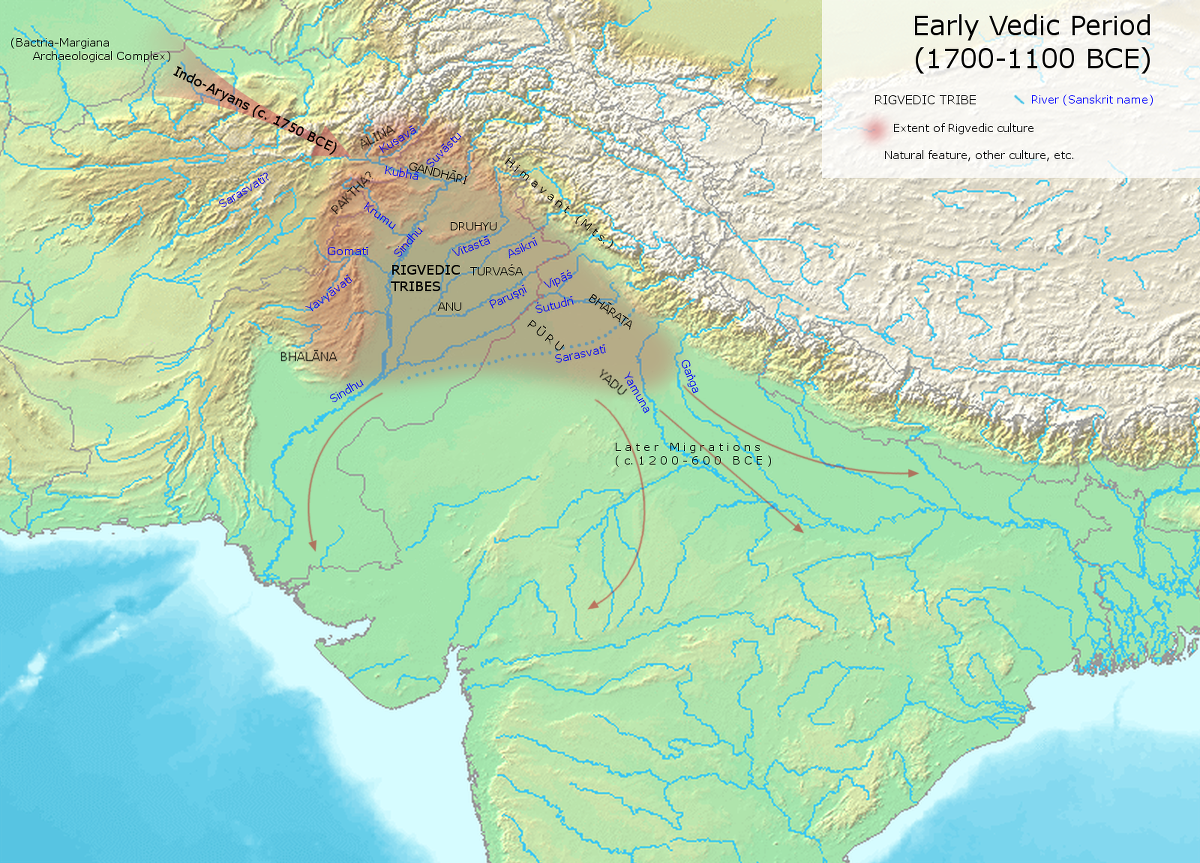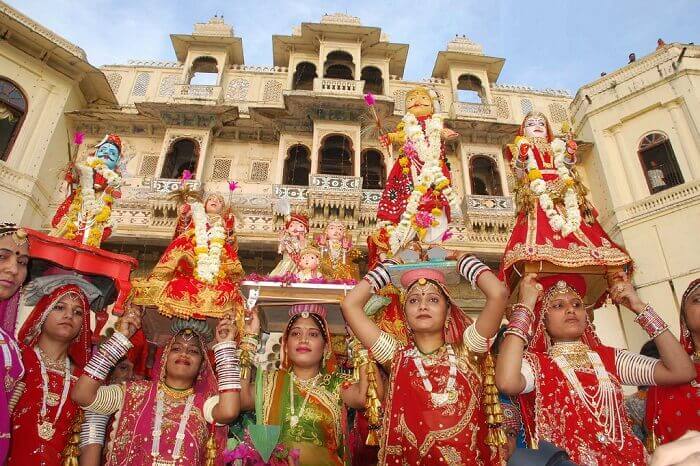The cities of the Harappan Culture had declined by 1500 B.C. Around this period, the speakers of Indo-Aryan language, Sanskrit, entered the north-west India from the Indo-Iranian region. Initially they would have come in small numbers through the passes in the northwestern mountains. Their initial settlements were in the valleys of the north-west and the plains of the Punjab.
Later, they moved into Indo-Gangetic plains. As they were mainly a cattle-keeping people, they were mainly in search of pastures. By 6th century B.C., they occupied the whole of North India, which was referred to as Aryavarta. The original home of the Aryans is a debatable question and there are several views.
This period between 1500 B.C and 600 B.C may be divided into:
- The Early Vedic Period or Rig Vedic Period (1500 B.C -1000 B.C) and
- The Later Vedic Period (1000B.C – 600 B.C).
Why it is called Vedic Period ?
The word ‘Veda’ is derived from the root ‘vid’, which means to know. In other words, the term ‘Veda’ signifies ‘superior knowledge’. The Vedic literature consists of the four Vedas – Rig, Yajur, Sama and Atharva.
- The Rig Veda is the earliest of the four Vedas and it consists of 1028 hymns.
- The Yajur Veda consists of various details of rules to be observed at the time of sacrifice.
- The Sama Veda is set to tune for the purpose of chanting during sacrifice. It is called the book of chants and the origins of Indian music are traced in it.
- The Atharva Veda contains details of rituals.
Rig Vedic Age or Early Vedic Period (1500 – 1000 B.C.)

Location:
During the Rig Vedic period, the Aryans were mostly confined to the Indus region. The Rig Veda refers to Saptasindhu or the land of seven rivers. This includes the five rivers of Punjab, namely Jhelum, Chenab, Ravi, Beas and Sutlej along with the Indus and Saraswathi.
Political System:
- Family was called as kula.
- Several families joined together on the basis of their kinship to form a village or grama. The leader of grama was known as gramani.
- A group of villages constituted a larger unit called visu. It was headed by vishayapati.
- The highest political unit was called jana or tribe.
- There were several tribal kingdoms during the Rig Vedic period such as Bharatas, Matsyas, Yadus and Purus. The head of the kingdom was called as rajan or king.
- The Rig Vedic polity was normally monarchical and the succession was hereditary. The king was assisted by purohita or priest and senani or commander of the army in his administration.
- There were two popular bodies called the Sabha and Samiti. The Sabha seems to have been a council of elders and the latter, a general assembly of the entire people.
Social Life:
- The Rig Vedic society was patriarchal. The basic unit of society was family or graham. The head of the family was known as grahapathi.
- Monogamy was generally practiced while polygamy was prevalent among the royal and noble families.
- Women were given equal opportunities as men for their spiritual and intellectual development. There were women poets like Apala, Viswavara, Ghosa and Lopamudra during the Rig Vedic period.
- Women could even attend the popular assemblies. There was no child marriage and the practice of sati was absent.
- Both men and women wore upper and lower garments made of cotton and wool.
- Chariot racing, horse racing, dicing, music and dance were the favourite pastimes.
- The social divisions were not rigid during the Rig Vedic period as it was in the later Vedic period.
Economic Condition:
- The Rig Vedic Aryans were pastoral people and their main occupation was cattle rearing. Their wealth was estimated in terms of their cattle.
- When they permanently settled in North India they began to practice agriculture. With the knowledge and use of iron they were able to clean forests and bring more lands under cultivation.
- Carpentry was another important profession and the availability of wood from the forests cleared made the profession profitable. Carpenters produced chariots and ploughs.
- Workers in metal made a variety of articles with copper, bronze and iron. Spinning was another important occupation and cotton and woolen fabrics were made. Goldsmiths were active in making ornaments.
- The potters made various kinds of vessels for domestic use.
- Trade was another important economic activity and rivers served as important means of transport. Trade was conducted on barter system. In the later times, gold coins called nishka were used as media of exchange in large transactions.
Religion:
- The Rig Vedic Aryans worshiped the natural forces like earth, fire, wind, rain and thunder.
- The important Rig Vedic gods were Prithvi (Earth), Agni (Fire), Vayu (Wind), Varuna (Rain) and Indra (Thunder).
- There were also female gods like Aditi and Ushas.
- There were no temples and no idol worship during the early Vedic period.
- Prayers were offered to the gods in the expectation of rewards. Ghee, milk and grain were given as offerings. Elaborate rituals were followed during the worship.
Later Vedic Period or Iron Age (1000 – 600 B.C.)

Location:
- The Aryans further moved towards east in the Later Vedic Period. The Satapatha Brahmana refers to the expansion of Aryans to the eastern Gangetic plains.
- Kuru and Panchala kingdoms flourished in the beginning. After the fall of Kurus and Panchalas, other kingdoms like Kosala, Kasi and Videha came into prominence.
- The later Vedic texts also refer to the three divisions of India – Aryavarta (northern India), Madhyadesa (central India) and Dakshinapatha (southern India).
Political System:
- Larger kingdoms were formed during the later Vedic period. Many jana or tribes were amalgamated to form janapadas or rashtras in the later Vedic period.
- The king performed various rituals and sacrifices to strengthen his position. They include Rajasuya (consecration ceremony), Asvamedha (horse sacrifice) and Vajpeya (chariot race).
- The kings also assumed titles like Rajavisvajanan, Ahilabhuvanapathi, (lord of all earth), Ekrat and Samrat (sole ruler).
- In the later Vedic period, a large number of new officials were involved in the administration in addition to the existing purohita, senani and gramani. They include the treasury officer, tax collector and royal messenger.
- At the lower levels, the administration was carried on by the village assemblies. The importance of the Samiti and the Sabha had diminished during the later Vedic period.
Social System:
- The four divisions of society (Brahmins, Kshatriyas, Vaisyas and Sudras) or the Varna system was thoroughly established during the Later Vedic period.
- Position of women declined, they were still considered inferior and subordinate to men. Women also lost their political rights of attending assemblies.
- Child marriages had become common.
Economic Condition:
- Iron was used extensively in this period and this enabled the people to clear forests and to bring more land under cultivation. Agriculture became the chief occupation. Improved types of implements were used for cultivation. Besides barley, rice and wheat were grown.
- Metal work, leather work, carpentry and pottery made great progress. In addition to internal trade, foreign trade became extensive. The Later Vedic people were familiar with the sea and they traded with countries like Babylon.
- Vaisyas also carried on trade and commerce. They organized themselves into guilds known as ganas.
- Besides nishka of the Rig Vedic period, gold and silver coins like satamana and krishnala were used as media of exchange.
Religion:
- Gods of the Early Vedic period like Indra and Agni lost their importance.
- Prajapathi (the creator), Vishnu (the protector) and Rudra (the destroyer) became prominent during the Later Vedic period.
- Sacrifices were still important and the rituals connected with them became more elaborate. The importance of prayers declined and that of sacrifices increased.
- Priesthood became a profession and a hereditary one. The formulae for sacrifices were invented and elaborated by the priestly class. Therefore, towards the end of this period there was a strong reaction against priestly domination and against sacrifices and rituals. The rise of Buddhism and Jainism was the direct result of these elaborate sacrifices.
- Also, the authors of the Upanishads, which is the essence of Hindu philosophy, turned away from the useless rituals and insisted on true knowledge (jnana) for peace and salvation
Vedic Age or Iron Age in Rajasthan:
From 1000 BC, Iron was used in Gandhara in Pakistan. Around same time, use of iron appeared in eastern Punjab, Wester UP and Rajasthan. The Vedic literature mentions the Matsyas and the Salvas as located near the river Saraswati and there is evidence to believe that by the close of the Vedic age Rajasthan had become fully colonized by the Vedic tribes.
The relics of Painted Grey ware culture have been reported from the dried- up beds of Saraswati and Drshadvati rivers. There is also evidence of Painted Grey Ware (PGW) from Noh (Bharatpur), Jodhpur (Jaipur), Viratnagar (Jaipur) and Sanari (Jhunjhunu). These sites represent the growth of Iron Age in Rajasthan.

